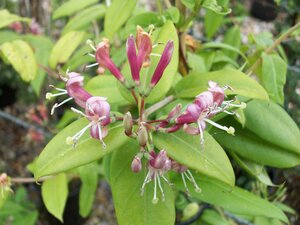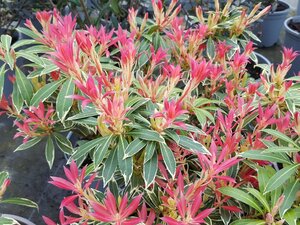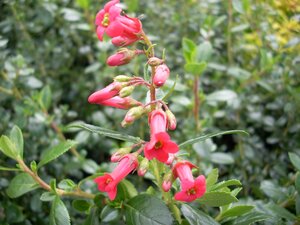Lonicera x b. Dropmore Scarlet
Why Buy Me?
- Long flowering period
- Likes full sun
- Great for trellis, pergolas or arches
Growing Conditions
Light:
Full sun to partial shade. Requires at least 6 hours of direct sunlight per day for best flowering. Tolerates partial shade but may flower less profusely in lower light.
Soil:
Moist, well-drained, fertile soil. Prefers loamy or sandy soils with neutral to slightly acidic pH. Avoid heavy clay or waterlogged conditions, which can hinder growth and reduce flowering.
Exposure:
Ideal for sunny or lightly shaded sites. Grows well on trellises, fences, pergolas, arches, or obelisks. Protect from strong, drying winds to prevent damage to flowers and foliage.
Drought Tolerance:
Moderate. Requires regular watering during dry periods, especially during establishment and active growth. Once established, tolerates short dry spells but performs best with consistent moisture.
Cultivation & Care
Planting Time:
Plant in early spring after the last frost or in early autumn to allow the root system to establish before harsh weather.
Spacing:
Space 1–1.5 m (3–5 ft) apart if planting multiple specimens. Grows 3–5 m (10–16 ft) tall with support, making it suitable for medium to large vertical garden structures.
Watering & Fertilization:
Water thoroughly during dry spells and during flowering. Feed in early spring with a balanced fertilizer to support healthy growth and blooms. A second feeding after the main flowering flush may promote extended blooming.
Mulching & Pruning:
Apply mulch in spring to retain soil moisture and suppress weeds.
Pruning Group 2:
Prune in late winter or early spring to shape and remove dead or weak growth. After flowering, lightly trim to maintain a tidy habit and encourage new growth.
Propagation:
Propagate by semi-ripe cuttings in summer or by layering. This cultivar is usually propagated vegetatively to maintain its vibrant flower characteristics.
Seasonal Interest
Spring:
New green shoots emerge in spring. Foliage is blue-green and attractive. Flower buds begin forming toward late spring.
Summer:
Main flowering occurs from early to late summer. Produces vibrant clusters of tubular, bright scarlet-orange flowers with yellow throats. Blooms are non-fragrant but visually striking and long-lasting.
Autumn:
Occasional flowers may continue into early autumn. Foliage remains attractive before dropping in colder regions.
Winter:
Deciduous to semi-evergreen depending on climate. Stems may remain visible for structural interest; prune before spring to encourage healthy new growth.
Wildlife & Garden Use
Wildlife:
Highly attractive to hummingbirds (in suitable regions), butterflies, and bees due to its nectar-rich, tubular flowers. Less appealing to deer and rabbits. Occasional small berries may be eaten by birds.
Garden Use:
A bold, colourful climber ideal for adding vertical impact to fences, trellises, arches, and arbors. Well-suited to cottage gardens, wildlife gardens, and contemporary designs needing strong flower colour. Can be used to cover unsightly structures or grow into small trees for a naturalistic effect.
Companion Plants:
Pairs well with purple or blue flowering plants like Clematis ‘Jackmanii’, Salvia nemorosa, and Nepeta. Complements ornamental grasses and silver-foliage plants like Artemisia or Lavandula. Also works well with climbing roses for a vibrant summer display.
Don’t miss out on the exceptional quality of the Lonicera x b. Dropmore Scarlet. It’s just a few clicks away when you order online, or you can stop by your nearest Thompson's Branch to pick one up and chat with our knowledgeable team.
-
EAN code9000000022
- Brand
- AspectSun or Shade
- Flower ColourRed
- Foliage ColourBlue/Green
- Width in ft4-5ft (120-150cm)
- Height in ft9-10ft (275-300cm)
- Pot size2 litre pot
- Flowering PeriodJuly/October
Collect your Order from one of our sites!
Order and pay online and select the day you would like to collect your order from one of our four sites.
Local deliveries available, please order and pay online for delivery within 5 working days. See our terms & conditions.




